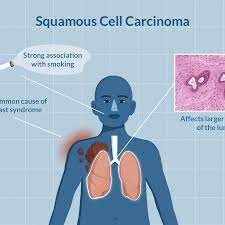Squamous Cell Carcinoma - Causes and Treatment

What Is Squamous Cell Carcinoma?
Squamous cell carcinoma (also known as squamous cell
carcinoma of the skin) is an uncommon type of cancer that starts from the cells
in your skin. It affects mostly older people and it's more common in men than
women.
Historically, squamous cell carcinoma often began on
the soles of your feet or other sun-exposed parts of your body.
In recent years, however, it has been reported to start
in non-sun exposed areas such as ear canals and genitals. It's sometimes
treated with surgery but there is a chance that it will return after treatment
if not treated aggressively enough.
What Causes Squamous Cell Carcinoma?
Squamous cell carcinoma is a form of skin cancer. It
begins in your skin cells. Skin cancer is often caused by long-term exposure to
the sun's ultraviolet rays, which can lead to changes in the DNA of your skin
cells and cause them to grow out of control.
Ultraviolet rays from tanning beds and sun lamps also
can cause this type of cancer, as can non-ionizing radiation from X-ray
machines or radium that was used for medical purposes in the past.
Squamous cell carcinoma also can be caused by exposure
to certain chemicals and other substances, including:
·
Arsenic compounds, such as wood preservatives or
insecticides;
·
Some chemicals used in the rubber and paint
industries; and
·
Tar can be used as a sealant for roadways and
roofs.
People exposed to these substances may develop squamous
cell carcinoma of the skin or other types of skin cancer, depending on how much
they were exposed to and for how long.
Some people may get only a small number of tumors
caused by these substances. These people usually don't have an increased risk
of getting other types of cancer. Other people exposed to these substances may
develop many different tumors.
However, squamous cell carcinoma is not an inherited
disease. You cannot get squamous cell carcinoma from your parents or other
members of your family.
What Are The Symptoms Of Squamous Cell Carcinoma?
The main symptom of squamous cell carcinoma is a red,
raised bump that may be itchy and painful.
Also, the bump may be sore and there may be drainage
from the area. However, sometimes people do not know they have cancer because
it can look like something else such as acne, rash or a pimple.
The early stages of melanoma often look like a
non-cancerous nodule on the skin.
Frequently Asked Questions
Do I Need To Remove Moles Or Growths On My Skin?
Moles are very common and more than likely benign so
they do not need to be removed.
However, if the mole or growth is unsightly, causes you
anxiety or discomfort, changes in size or shape, itches, causes a bad odor or
ulcerates you should consider it for removal.
What Are The Treatments/Procedures For Squamous Cell Carcinoma?
In general, squamous cell carcinoma is treated with
surgery. If advanced cancer has spread to other parts of your body and there
isn't sufficient tissue remaining for complete excision of your skin cancer,
radiation therapy may be used after surgery to kill any cancer cells that may
have been missed during the surgery. However, radiation therapy has its risks
including side effects such as fatigue and hair loss.
Is There A Cure For Squamous Cell Carcinoma?
If your cancer is treated before it spreads to your
lymph nodes or elsewhere, the 5-year survival rate is almost 100%.
However, more advanced squamous cell carcinoma may
spread to other parts of the body before it is found. If this happens, you will
need treatment with chemotherapy and/or radiation. However, these treatments
have their risks including side effects such as fatigue and hair loss.
Also, cancers that have spread are not always cured by
treatment. But with advances in medical research and treatment for this type of
cancer, most people with squamous cell carcinoma can be successfully treated.
How Can I Prevent Squamous Cell Carcinoma?
To help reduce your risk of developing squamous cell
carcinoma, stay out of the sun completely or wear protective clothing,
including a wide-brimmed hat with a wide face shield to protect your face,
neck, and ears.
If you are going to be in the sun for more than 30
minutes, use sunscreen with an SPF of at least 15. Use one that blocks both
ultraviolet A (UVA) and ultraviolet B (UVB) rays. There are two types of UV
rays from sunlight: UVA and UVB. Both can cause skin cancer.
